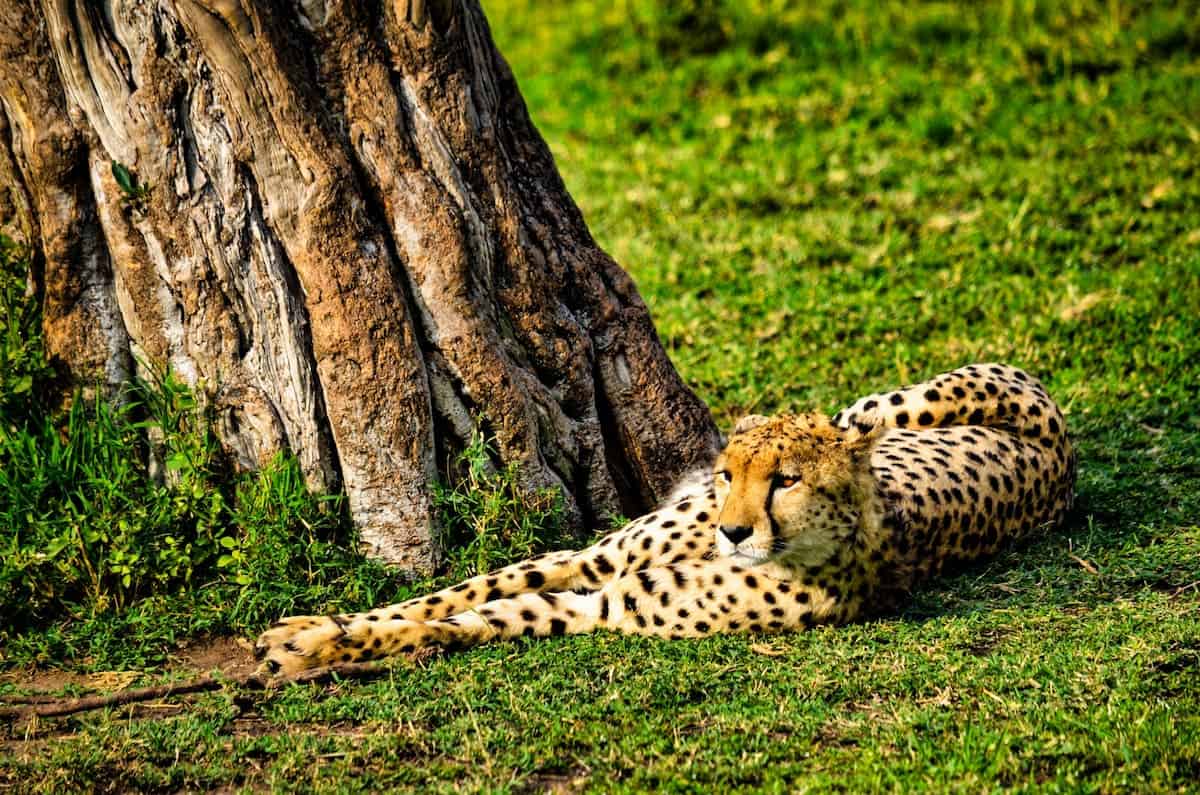Wildlife programs often show tigers hunting prey and napping in the sun. So, where do tigers go to sleep?
Tigers may sleep in a shaded area, such as near trees in the forest or the mouth of a cave. Most tigers also sleep within the boundaries of their territory. While tigers often sleep in shaded spots, they may also find other places to rest, such as shallow bodies of water or tall grass. Keep reading to explore the various places that tigers sleep in the wild.
So, where Do Tigers Sleep?
Tigers sleep almost anywhere that they choose. The sleeping spot often depends on the environment, as tigers are found in a diverse range of habitats, including grasslands, forests, mountains, and swamps.
Some of the most common resting spots for tigers include:
- On top of rocks
- Under trees or bushes
- In dense grass
- In shallow water
- In the mouth of a cave
- Under fallen logs
- Near rock formations
Most species of tigers are nocturnal and sleep up to 16 hours per day in a secluded area within their territory. The remaining eight hours are spent stalking prey and eating, which typically occurs at night.
After capturing prey and feeding, tigers need a nap. Most of the prey that tigers catch can be eaten for several days. Instead of leaving the uneaten food, tigers sleep near it. Finding a different spot to sleep would require more energy and allow other animals to take their food.
In the regions where they live, tigers are typically at the top of the food chain. Unlike most other animals, they do not need to seek shelter for protection against predators, as they are the predators. This allows them to sleep just about anywhere that they want.
Tigers in warm regions may occasionally nap under the sun but are typically found sleeping in shaded areas. They may find shade under trees or bushes. Tigers in cold regions may seek shelter near caves or rock formations.
Tigers in tropical climates may also occasionally rest in shallow watering holes to cool off during the summer. The water also helps keep biting flies away. Tigers in cooler regions may prefer to sleep in areas that provide shelter from the wind, such as a cave entrance.
The Sleeping Habits of Tigers Depend on the Species
The various species of tigers live in different regions, which impacts where they sleep. Scientists have identified nine species of tigers, but only five remain in the wild:
- Bengal tigers
- Malayan tigers
- Indo-Chinese tigers
- Sumatran tigers
- Siberian tigers
Bengal tigers typically sleep in forests and grasslands and may drag their kills up to a mile to find a suitable hiding spot to eat and sleep. The Malayan tigers are found in tropical areas of Thailand and Malaysia. They are nocturnal and often sleep in elevated areas, such as on trees or fallen logs.
The Indo-Chinese tigers live in forests and hilly terrain in Thailand, Vietnam, and the surrounding regions. They prefer to sleep in secluded areas where they can remain concealed.
The Sumatran tigers live on the island of Sumatra in Indonesia. They may sleep in caves or grassy fields, depending on the season. They may seek shelter during the winter and rest in cool grass during the summer.
The Siberian (Amur) tiger is found in cool areas of eastern Russia and northern China. Instead of seeking a shady spot to sleep, Siberian tigers often may seek protection against cold winds, such as a cave or under fallen trees.
Tigers Sleep Inside Their Territories
Tigers are territorial animals and typically sleep within the boundaries of their territories. They are also solitary animals. They sleep alone and spend most of their time away from other tigers. The only time that a tiger may sleep around others is during their adolescence.
A lone female tiger may have a territory that covers about 15 to 20 square kilometers. The female tigers raise cubs. The cubs eventually go off to find their own territories. A lone male tiger may have a territory that encompasses the territories of several female tigers. Male territories can cover 100 or more square kilometers.
Tiger Clubs Sleep in a Den
Female tigers give birth every 2 to 2.5 years and have up to seven cubs in a litter. The young cubs sleep together in a den prepared by the mother before their birth. The den is typically a secluded spot, such as a crevice near a rock formation or the entrance to a cave.
Some tigers may also use an area with dense grass as a den or find a hollowed-out tree. The den is also often near the area where the female tiger gives birth, which is often a field or spot in the forest with tall grass.
For the first two months of their lives, tiger cubs spend most of their time sleeping and playing in the den. If the mother needs to find a different place for her litter to sleep, she will use her teeth to gently carry them by the scruff of their necks to the new location.
Where Do Tigers Sleep During the Winter?
Tigers typically sleep in the same areas throughout the year. Wild tigers do not need to worry too much about cold weather due to their thick skin and fur coats. Siberian tigers live in northeast China and eastern Russia where the temperatures get very cold. However, they have extra fur around their paws and necks to keep them warm and an extra layer of fat.
Conclusion
Siberian and Sumatran tigers may occasionally find shelter in caves or under fallen logs. However, most tigers simply sleep wherever they choose.
The five remaining species of tigers are often found sleeping in shaded areas and within reach of their most recent kill. After capturing prey, they may drag it to a secluded area, eat, and take a nap. Tigers often sleep near thick vegetation or under trees for shade. They may also find a comfortable spot on a muddy road or in shallow water.





